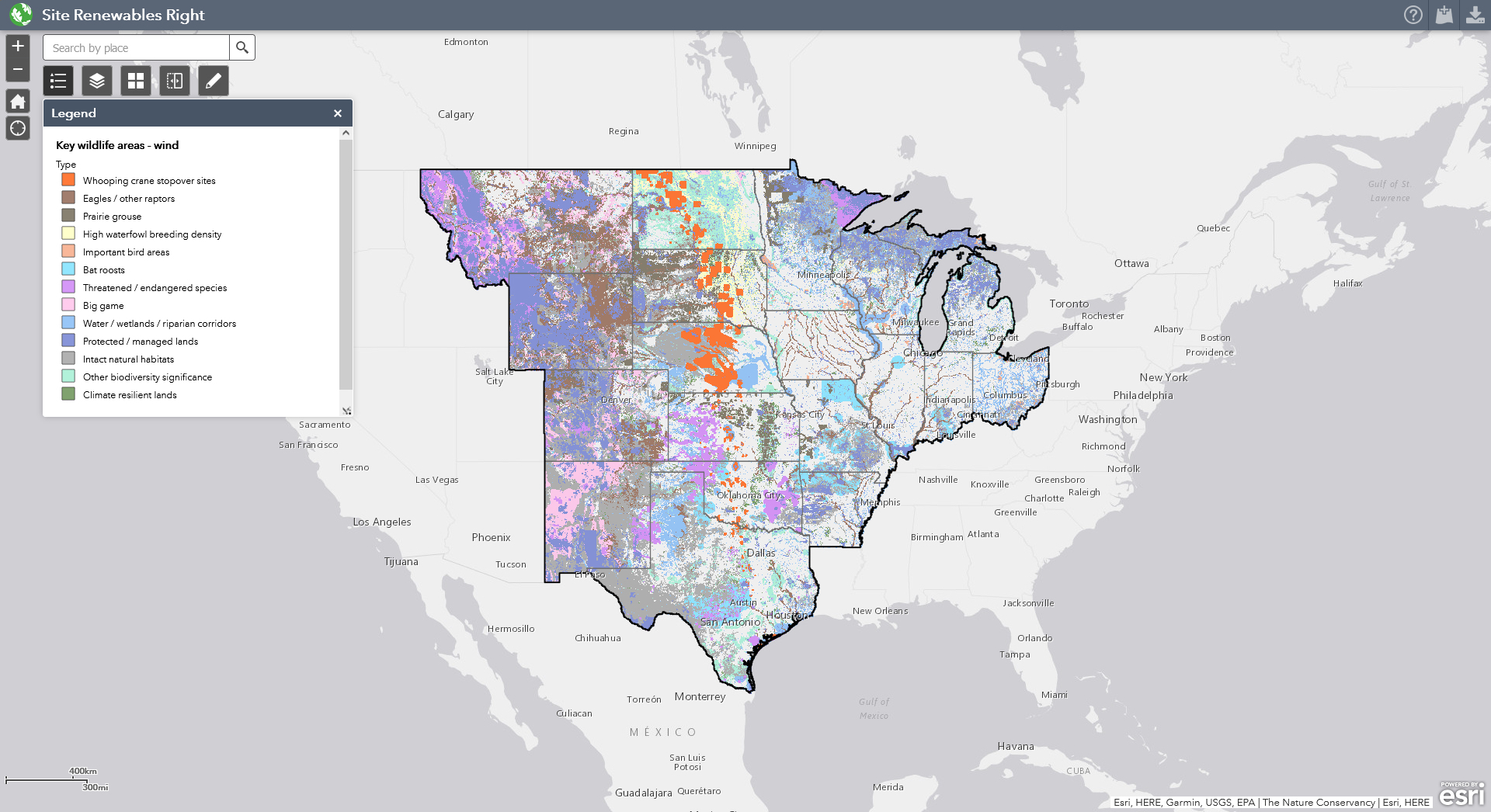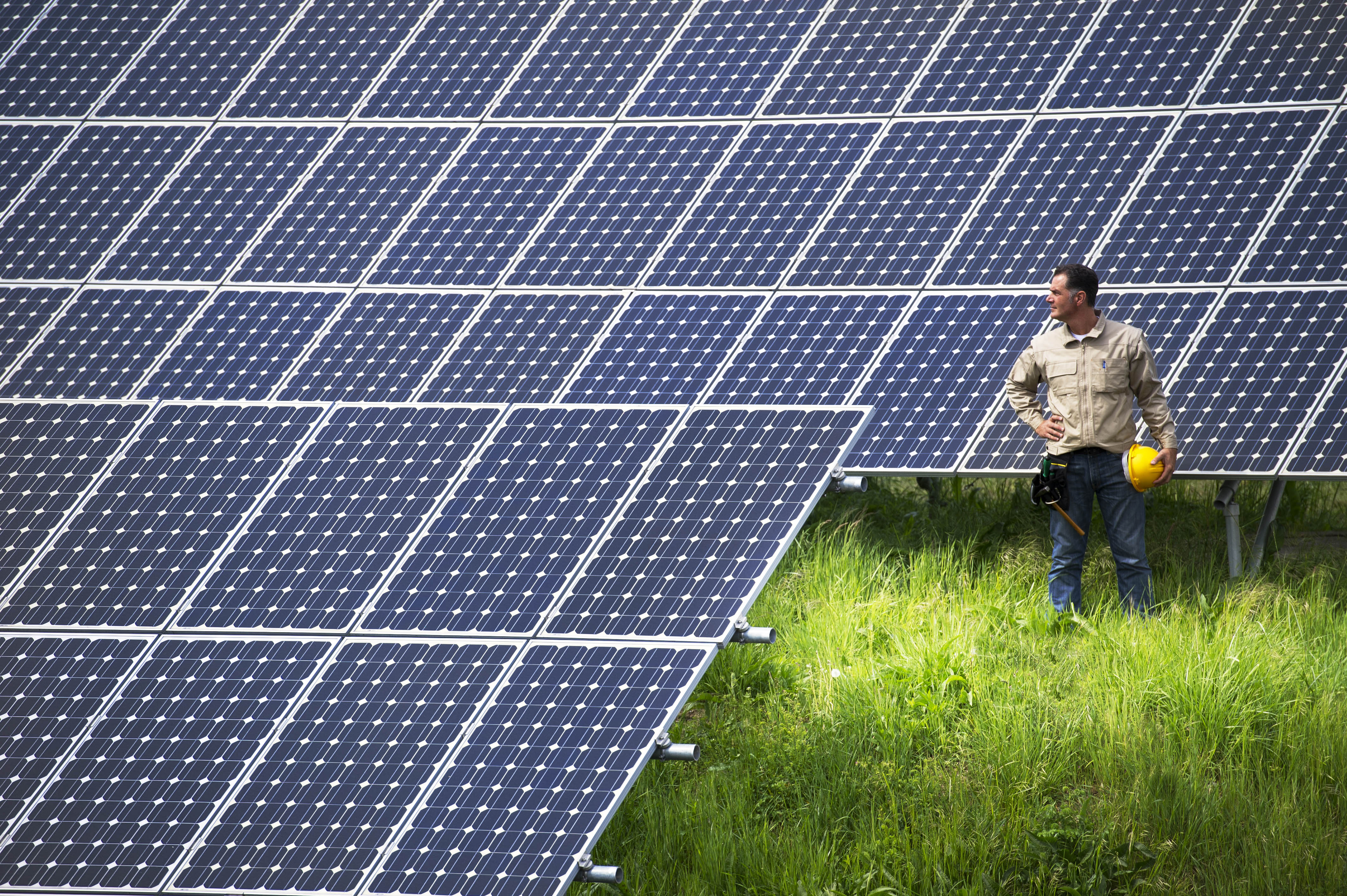How can we speed up the transition to renewable energy?
Our vision is for a clean, green, and equitable energy future. The world needs at least a nine-fold increase in renewable energy production to meet the Paris Agreement climate goals and much more to achieve net zero emissions by 2050. The rapid transition to renewable energy will be good for people and the planet. But the land-use footprint for this buildout will be large because renewable energy infrastructure requires a lot of land—especially onshore wind and large-scale solar installations. This raises the potential for land-use conflicts over renewable energy. We need to go smart to go fast—deploying renewable energy in ways that support goals for climate, conservation, and communities.
Driving the Energy Transition
By delivering innovative strategies grounded in leading science, partnerships, public policy, and market-based approaches, TNC is helping catalyze a rapid renewable energy buildout that safeguards nature and supports an equitable transition for communities.
TNC is currently focusing on the United States, Europe, and India, and piloting strategies in Africa, China, and Latin America. We are working with multilateral institutions and partners around the world to share knowledge and influence commitments, to support a low conflict, low carbon, and community-friendly renewable energy future.

Global Renewables Watch
Global Renewables Watch will be a regularly updated atlas of utility-scale solar and wind installations around the world.
Check out this upcoming tool
Identifying the Best Places for Renewable Energy
-

Site Renewables Right
To help accelerate the deployment of wind and solar energy in a way that helps people and nature thrive, The Nature Conservancy is providing the award-winning Site Renewables Right map. See the Science
-

SiteRight in India
Advancing the rapid deployment of renewable energy in India to meet rising energy demand while mitigating climate change. See SiteRight in India
-

Building Europe's Renewable Energy Future
Europe has set the goal of being the first climate neutral continent. TNC is working to turn decarbonization commitments into renewable acceleration plans for countries across Europe that also bring benefits for nature and people. Take a Look at the Future
Planning for a Clean and Green Future
-

Power of Place: Net-Zero Strategies for Energy Planners and Policymakers
Power of Place-National lays out a vision and recommendations that steer energy planners and policymakers towards thoughtful net-zero strategies that benefit climate, conservation and communities. See our Power of Place - National Report
-

Clean Energy Solutions that Protect People and Nature in the West
Power of Place-West is TNC's study that shows high electrification is the best path for meeting climate and land conservation goals. See the Opportunities of Renewable Power in the U.S. West
-

Global Clean Energy Potential Tool
Converted lands can provide lower-conflict solutions for new renewable energy installations. TNC’s interactive tool shows how. See How We Can Meet Global Clean Energy Goals While Protecting Natural Lands
-

A Blueprint for North Macedonia
The Western Balkan country is quickly leaving its coal-powered past behind. TNC research has identified twice the land needed to meet the country’s electricity demand by prioritizing development in brownfields and degraded and converted lands. Learn How We're Accelerating the Transition
Advancing Policies and Markets for Renewables
-

Six Pathways to a Clean and Green Renewable Energy Buildout
Accelerating clean energy development is critical—here’s how we do it the right way. See the Six Pathways to a Clean & Green Energy Buildout
-

Beyond Carbon-Free: A Framework for Purpose-Led Renewable Energy
This report by LevelTen Energy, The Nature Conservancy and the National Audubon Society guides the renewable energy industry toward a sustainable and equitable clean energy transition. Download Beyond Carbon-Free White Paper
Driving Benefits for Communities and Nature
-

Enabling a Community-Powered Energy Transition
This study developed with the University of Cambridge Institute of Sustainability Leadership outlines emerging practices for engaging stakeholders and fostering collaboration to ensure the socioeconomic Download the report
-

Mining the Sun in Nevada and West Virginia
Nevada and West Virginia, two states with very different identities, are finding themselves on the cutting edge of clean energy opportunity by repurposing former mine lands with solar energy. See the Opportunities for Mining the Sun
-

Long Island Solar Roadmap
A new report details how to advance clean energy development on New York's Long Island while safeguarding the places people value most. Follow the Long Island Roadmap
-

A Marine Mapping Tool to Guide Offshore Wind Development
TNC scientists are mapping offshore waters in the Atlantic to ensure the best data about species are used to make decisions about the ocean. See How Science Can Guide Offshore Wind Development
Saving Rivers and Transitioning from Fossil Fuels
-

A Brighter Future
We must push for low-conflict, low-cost development of clean energy. Discover the solutions in this interactive overview. See the Path for a Brighter Clean Energy Future
-

Safeguarding the Okavango Delta
TNC is working with the Angolan government and international energy company Gesto to create a master plan that prioritizes low-impact renewable energy sources, like solar power, over traditional large-scale hydropower. See How Partnerships Can Protect Rivers and Provide Clean Energy
Perspectives
-
The global transition to clean energy must happen fast to meet climate goals. This looks more possible than ever. Here are three things companies can do to help drive a clean and green transition.
-
By planning, siting and buying renewable energy right, we can get to a net-zero future—one in which people and nature thrive.
-
Perspective from TNC’s Mark Lambrides shares why he is optimistic about clean energy systems helping meet the world’s climate change targets.
-
By strategically planning the use of land, India can ensure that renewable energy projects are set up in places with high potential for power generation, but that also avoid harm to nature, wildlife or people.
-
Joe Kiesecker, TNC’s Lead Scientist on Land and Water, details his perspectives on how India can achieve universal energy access while also protecting its critical habitats.
-
TNC's Southeast Europe lead is trying to help protect rivers as the continent races to boost renewable energy and reduce dependence on Russian gas.
Reports
-
Optimizing Impact of Clean Energy Procurement: Growing Demand for Social and Environmental Outcomes
-
TNC works with Salesforce and partners to promote high standards for renewable energy development.
-
By planning solar and wind renewable energy projects in areas with a lower conservation priority, project developers can avoid the most severe potential negative impacts on biodiversity.
-
This report details paths to decarbonization while limiting impacts of energy development on high value natural and agricultural lands in California.
-
This interactive energy tool visualizes trade-offs between energy, carbon emissions and land use based on the world’s project energy needs.
-
The Nature Conservancy (TNC) has a goal to mitigate 3 billion metric tons of carbon annually by 2030. Accelerating a clean, green and equitable renewable energy transition is critical to meeting this goal. This annual report highlights TNC’s 2023 renewable energy work.
-
The Clean Air Task Force, TNC and the Natural Resources Defense Council launched a new report that assesses siting and permitting policies for renewable energy development and recommends policy solutions.
Science & Tools
-
The Purpose-Driven Toolkit is an integrated suite of clean energy procurement resources that embed 3C principles. It includes the following tools.
This is a template for assessing impact and identifying projects that stand out from a 3C perspective. This form provides a standard scoring methodology and customization features if there are certain issues that a buyer would like to prioritize.
The RFP Template and Narrative Questionnaire
The template and questionnaire provide background language to help buyers communicate their preferences for projects with strong 3C characteristics through their initial RFP.
Power with Purpose:
Driving Change Through Clean Energy Procurement
Low resolution version (2MB)Power with Purpose
Hi resolution version (25MB)This case study shares the lessons learned and best practices for applying the 3C framework based on a national procurement process. The study describes the partnership between electric vehicle manufacturer Rivian and The Nature Conservancy (TNC), which used their organizational strengths and expertise to develop guidance for other companies to meet their renewable energy needs while enabling system-wide 3C benefits. It provides a market-tested open-source toolkit, including sample Request for Proposals (RFP) content, a complete Offer Form and scoring template, assessment guidance, and other recommendations for developing a purpose-driven procurement process. These tools are intended for industry leaders to use and adapt, in a way that is consistent with their company values, to accelerate the adoption of purpose-driven clean energy projects.
-
How do we meet global clean energy goals while protecting natural lands?
-
This report details the unintended environmental impacts on critical habitats and ecosystems from renewable energy development.
-
This handbook for practitioners provides guidance for planning renewable energy deployment.

